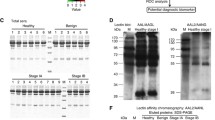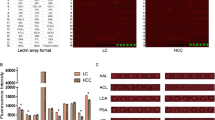Abstract
Glycoproteomics is an important aspect in the research of cancer biomarker discovery. The objective of our study is to screen the profile of serum glycoproteins in hepatocellular carcinoma (HCC) patients and to discover differentially expressed glycoproteins in HCC with or without metastasis. We collected serum from HCC patients and divided them into two groups (non-metastatic HCC group and metastatic HCC group) according to 2002 UICC TNM staging system. Wheat germ agglutinin (WGA) lectin was used to enrich the serum glycoproteins by lectin affinity chromatography. The enriched glycoproteins were labeled with mass-balanced isobaric tags (iTRAQ) and analyzed by liquid chromatography–tandem mass spectrometry (LC–MS/MS). Two differential glycoproteins were validated by Western blot and biochemical methods, respectively. Fifteen differential serum glycoproteins with WGA affinity were identified (p < 0.05). Among them, nine proteins were up-regulated (>1.5-folds) and six were down-regulated (<0.5-folds) in HCC patients with metastasis. Expression of alpha-1-antitrypsin (SERPINA1) and apolipoprotein A-I (APOA1) was validated by Western blot and biochemical methods, respectively (p < 0.05). Our study has obtained a set of HCC metastasis-associated glycoproteins which may serve as novel prognostic candidates and potential therapeutic targets for HCC metastasis. SERPINA1 might act as a potential glycoprotein biomarker of HCC metastasis.









Similar content being viewed by others
References
Parkin DM, Bray F, Ferlay J, Pisani P. Global cancer statistics, 2002. CA Cancer J Clin. 2005;55(2):74–108.
Bosch FX, Ribes J, Diaz M, Cleries R. Primary liver cancer: worldwide incidence and trends. Gastroenterology. 2004;127(5 Suppl 1):S5–16.
Tateno H, Nakamura-Tsuruta S, Hirabayashi J. Comparative analysis of core-fucose-binding lectins from lens culinaris and pisum sativum using frontal affinity chromatography. Glycobiology. 2009;19(5):527–36.
Zeng Z, Hincapie M, Haab BB, Hanash S, Pitteri SJ, Kluck S, et al. The development of an integrated platform to identify breast cancer glycoproteome changes in human serum. J Chromatogr A. 2010;1217(19):3307–15.
Wang NY, Zhao W, Zhang D, Zhang YC, Duan MH. Clinical application of avidin-biotin ELISA to detect serum hepatoma-specific gamma-glutamyltransferase in patients with primary hepatic cancer. Zhonghua Zhong Liu Za Zhi. 2009;31(2):114–7.
Kelly LS, Birken S, Puett D. Determination of hyperglycosylated human chorionic gonadotropin produced by malignant gestational trophoblastic neoplasias and male germ cell tumors using a lectin-based immunoassay and surface plasmon resonance. Mol Cell Endocrinol. 2007;260–262:33–9.
Shao C, Chen S, Chen L, Cobos E, Wang JS, Haab BB, et al. Antibody microarray analysis of serum glycans in esophageal squamous cell carcinoma cases and controls. Proteomics Clin Appl. 2009;3(8):923–31.
Ang IL, Poon TC, Lai PB, Chan AT, Ngai SM, Hui AY, et al. Study of serum haptoglobin and its glycoforms in the diagnosis of hepatocellular carcinoma: a glycoproteomic approach. J Proteome Res. 2006;5(10):2691–700.
Ong SE, Mann M. Mass spectrometry-based proteomics turns quantitative. Nat Chem Biol. 2005;1(5):252–62.
Anderson NL, Anderson NG. The human plasma proteome: history, character, and diagnostic prospects. Mol Cell Proteomics. 2002;1(11):845–67.
Gahmberg CG, Tolvanen M. Why mammalian cell surface proteins are glycoproteins. Trends Biochem Sci. 1996;21(8):308–11.
Yang Z, Hancock WS. Approach to the comprehensive analysis of glycoproteins isolated from human serum using a multi-lectin affinity column. J Chromatogr A. 2004;1053(1–2):79–88.
Pilobello KT, Slawek DE, Mahal LK. A ratiometric lectin microarray approach to analysis of the dynamic mammalian glycome. Proc Natl Acad Sci USA. 2007;104(28):11534–9.
Chen QP, Sun C, Zhang S, et al. Comparative serum glycoproteomics of non-metastatic and metastatic Hepatocellular carcinoma by lectin affinity technology. Fudan Univ. J Med Sci. 2011;38(5):389–95.
Chen R, Tan Y, Wang M, Wang F, Yao Z, Dong L, et al. Development of glycoprotein capture-based label-free method for the high-throughput screening of differential glycoproteins in hepatocellular carcinoma. Mol Cell Proteomics. 2011;10(7):M110 006445.
Wang M, Long RE, Comunale MA, Junaidi O, Marrero J, Di Bisceglie AM, et al. Novel fucosylated biomarkers for the early detection of hepatocellular carcinoma. Cancer Epidemiol Biomarkers Prev. 2009;18(6):1914–21.
Wang C, Guo K, Gao D, Kang X, Jiang K, Li Y, et al. Identification of transaldolase as a novel serum biomarker for hepatocellular carcinoma metastasis using xenografted mouse model and clinic samples. Cancer Lett. 2011;313(2):154–66.
Tian J, Tang ZY, Ye SL, Liu YK, Lin ZY, Chen J, et al. New human hepatocellular carcinoma (HCC) cell line with highly metastatic potential (MHCC97) and its expressions of the factors associated with metastasis. Br J Cancer. 1999;81(5):814–21.
Jin GZ, Li Y, Cong WM, Yu H, Dong H, Shu H, et al. iTRAQ-2DLC-ESI-MS/MS based identification of a new set of immunohistochemical biomarkers for classification of dysplastic nodules and small hepatocellular carcinoma. J Proteome Res. 2011;10(8):3418–28.
McDonald CA, Yang JY, Marathe V, Yen TY, Macher BA. Combining results from lectin affinity chromatography and glycocapture approaches substantially improves the coverage of the glycoproteome. Mol Cell Proteomics. 2009;8(2):287–301.
Wang Y, Ao X, Vuong H, Konanur M, Miller FR, Goodison S, et al. Membrane glycoproteins associated with breast tumor cell progression identified by a lectin affinity approach. J Proteome Res. 2008;7(10):4313–25.
Selvaraju S, El Rassi Z. Tandem lectin affinity chromatography monolithic columns with surface immobilised concanavalin A, wheat germ agglutinin and ricinus communis agglutinin-I for capturing sub-glycoproteomics from breast cancer and disease-free human sera. J Sep Sci. 2012;35(14):1785–95.
Taketa K, Sekiya C, Namiki M, Akamatsu K, Ohta Y, Endo Y, et al. Lectin-reactive profiles of alpha-fetoprotein characterizing hepatocellular carcinoma and related conditions. Gastroenterology. 1990;99(2):508–18.
Lu Y, Liu P, Wen W, Grubbs CJ, Townsend RR, Malone JP, et al. Cross-species comparison of orthologous gene expression in human bladder cancer and carcinogen-induced rodent models. Am J Transl Res. 2010;3(1):8–27.
Hsu PI, Chen CH, Hsiao M, Wu DC, Lin CY, Lai KH, et al. Diagnosis of gastric malignancy using gastric juice alpha1-antitrypsin. Cancer Epidemiol Biomarkers Prev. 2010;19(2):405–11.
Ambrosini-Spaltro A, Poti O, De Palma M, Filotico M. Pancreatic-type acinar cell carcinoma of the stomach beneath a focus of pancreatic metaplasia of the gastric mucosa. Hum Pathol. 2009;40(5):746–9.
El-Akawi ZJ, Abu-Awad AM, Sharara AM, Khader Y. The importance of alpha-1 antitrypsin (alpha1-AT) and neopterin serum levels in the evaluation of non-small cell lung and prostate cancer patients. Neuro Endocrinol Lett. 2010;31(1):113–6.
Zhang D, Wu M, Nelson DE, Pasula R, Martin WJ 2nd. Alpha-1-antitrypsin expression in the lung is increased by airway delivery of gene-transfected macrophages. Gene Ther. 2003;10(26):2148–52.
Thakur A, Bollig A, Wu J, Liao DJ. Gene expression profiles in primary pancreatic tumors and metastatic lesions of Ela-c-myc transgenic mice. Mol Cancer. 2008;7:11.
de Sa SV, Correa-Giannella ML, Machado MC, Krogh K, de Almeida MQ. Albergaria Pereira MA, et al. Serpin peptidase inhibitor clade A member 1 as a potential marker for malignancy in insulinomas. Clin Cancer Res. 2007;13(18 Pt 1):5322–30.
Normandin K, Peant B, Le Page C, de Ladurantaye M, Ouellet V, Tonin PN, et al. Protease inhibitor SERPINA1 expression in epithelial ovarian cancer. Clin Exp Metastasis. 2010;27(1):55–69.
Wang X, Dai S, Zhang Z, Liu L, Wang J, Xiao X, et al. Characterization of apolipoprotein A-I as a potential biomarker for cholangiocarcinoma. Eur J Cancer Care (Engl). 2009;18(6):625–35.
Zhang Z, Bast RC Jr, Yu Y, Li J, Sokoll LJ, Rai AJ, et al. Three biomarkers identified from serum proteomic analysis for the detection of early stage ovarian cancer. Cancer Res. 2004;64(16):5882–90.
Chong PK, Lee H, Zhou J, Liu SC, Loh MC, So JB, et al. Reduced plasma APOA1 level is associated with gastric tumor growth in MKN45 mouse xenograft model. J Proteomics. 2010;73(8):1632–40.
Morandi F, Corrias MV, Levreri I, Scaruffi P, Raffaghello L, Carlini B, et al. Serum levels of cytoplasmic melanoma-associated antigen at diagnosis may predict clinical relapse in neuroblastoma patients. Cancer Immunol Immunother. 2011;60(10):1485–95.
Kim YS, Jung JA, Kim HJ, Ahn YH, Yoo JS, Oh S, et al. Galectin-3 binding protein promotes cell motility in colon cancer by stimulating the shedding of protein tyrosine phosphatase kappa by proprotein convertase 5. Biochem Biophys Res Commun. 2011;404(1):96–102.
Vural M, Camuzcuoglu H, Toy H, Camuzcuoglu A, Aksoy N. Oxidative stress and prolidase activity in women with uterine fibroids. J Obstet Gynaecol. 2012;32(1):68–72. doi:10.3109/01443615.2011.633718.
Kanoh Y, Ohtani H, Egawa S, Baba S, Akahoshi T. Levels of acute inflammatory biomarkers in advanced prostate cancer patients with alpha2-macroglobulin deficiency. Int J Oncol. 2011;39(6):1553–8.
Wong J, Sia YY, Misso NL, Aggarwal S, Ng A, Bhoola KD. Effects of the demethylating agent, 5-azacytidine, on expression of the kallikrein-kinin genes in carcinoma cells of the lung and pleura. Patholog Res Int. 2011;2011:167046.
Peng PH, Wu CC, Liu SC, Chang KP, Chen CD, Chang YT, et al. Quantitative plasma proteome analysis reveals aberrant level of blood coagulation-related proteins in nasopharyngeal carcinoma. J Proteomics. 2011;74(5):744–57.
Choi JW, Liu H, Song H, Park JH, Yun JW. Plasma marker proteins associated with the progression of lung cancer in obese mice fed a high-fat diet. Proteomics. 2012;12(12):1999–2013.
Lamszus K, Joseph A, Jin L, Yao Y, Chowdhury S, Fuchs A, et al. Scatter factor binds to thrombospondin and other extracellular matrix components. Am J Pathol. 1996;149(3):805–19.
Hamm A, Veeck J, Bektas N, Wild PJ, Hartmann A, Heindrichs U, et al. Frequent expression loss of Inter-alpha-trypsin inhibitor heavy chain (ITIH) genes in multiple human solid tumors: a systematic expression analysis. BMC Cancer. 2008;8:25.
Crivelini MM, de Araujo VC, de Sousa SO, de Araujo NS. Cytokeratins in epithelia of odontogenic neoplasms. Oral Dis. 2003;9(1):1–6.
Santos M, Ballestin C, Garcia-Martin R, Jorcano JL. Delays in malignant tumor development in transgenic mice by forced epidermal keratin 10 expression in mouse skin carcinomas. Mol Carcinog. 1997;20(1):3–9.
Yokomizo A, Takakura M, Kanai Y, Sakuma T, Matsubara J, Honda K, et al. Use of quantitative shotgun proteomics to identify fibronectin 1 as a potential plasma biomarker for clear cell carcinoma of the kidney. Cancer Biomark. 2011;10(3–4):175–83.
Seyama K, Nukiwa T, Takabe K, Takahashi H, Miyake K, Kira S. Siiyama (serine 53 (TCC) to phenylalanine 53 (TTC)). A new alpha 1-antitrypsin-deficient variant with mutation on a predicted conserved residue of the serpin backbone. J Biol Chem. 1991;266(19):12627–32.
Holmes MD, Brantly ML, Fells GA, Crystal RG. Alpha 1-antitrypsin Wbethesda: molecular basis of an unusual alpha 1-antitrypsin deficiency variant. Biochem Biophys Res Commun. 1990;170(3):1013–20.
Graham A, Kalsheker NA, Bamforth FJ, Newton CR, Markham AF. Molecular characterisation of two alpha-1-antitrypsin deficiency variants: proteinase inhibitor (Pi) Null (Newport) (Gly115—Ser) and (Pi) Z Wrexham (Ser-19—Leu). Hum Genet. 1990;85(5):537–40.
Hiemstra PS, Stolk J. From gene disease; alpha1-antitrypsin deficiency. Ned Tijdschr Geneeskd. 2003;147(16):758–60.
Hansson M, Jonsson S, Persson AM, Calafat J, Tapper H, Olsson I. Targeting proteins to secretory lysosomes of natural killer cells as a principle for immunoregulation. Mol Immunol. 2003;40(6):363–72.
Cekmen M, Evereklioglu C, Er H, Inaloz HS, Doganay S, Turkoz Y, et al. Vascular endothelial growth factor levels are increased and associated with disease activity in patients with Behcet’s syndrome. Int J Dermatol. 2003;42(11):870–5.
Walter S, Weinschenk T, Stenzl A, Zdrojowy R, Pluzanska A, Szczylik C, et al. Multipeptide immune response to cancer vaccine IMA901 after single-dose cyclophosphamide associates with longer patient survival. Nat Med. 2012.
Acknowledgments
This work was financially supported by National Basic Research Program of China (973 Program: 2011CB910604), China National Key Projects for Infectious Diseases (2008ZX 10002-021 and 2008ZX10002-017) and Guangxi natural science funds (2010GXNSFA013149).
Conflict of interest
There are no conflicts of interest regarding this paper.
Author information
Authors and Affiliations
Corresponding author
Additional information
Xue Qin and Qiaopei Chen contributed equally to this paper.
Rights and permissions
About this article
Cite this article
Qin, X., Chen, Q., Sun, C. et al. High-throughput screening of tumor metastatic-related differential glycoprotein in hepatocellular carcinoma by iTRAQ combines lectin-related techniques. Med Oncol 30, 420 (2013). https://doi.org/10.1007/s12032-012-0420-8
Received:
Accepted:
Published:
DOI: https://doi.org/10.1007/s12032-012-0420-8




